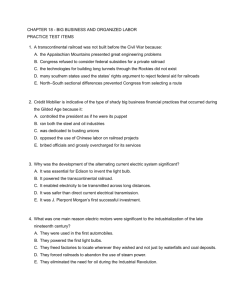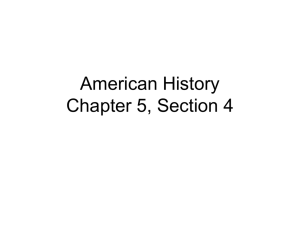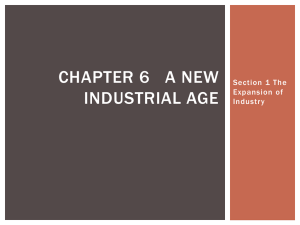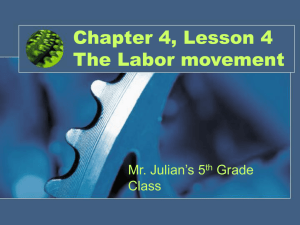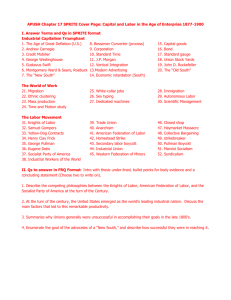Industrialization and the Rise of Big Business
advertisement
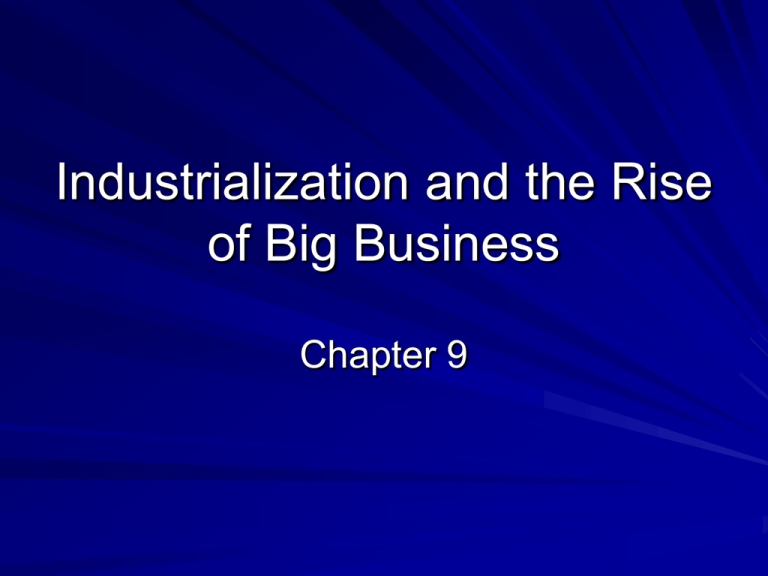
Industrialization and the Rise of Big Business Chapter 9 Did You Know? Alexander Graham Bell taught deaf children. He once told his family that he preferred to be remembered as a teacher rather than the inventor of the telephone. His father was a pioneer of Visible Speech. Industrialization With the end of the Civil War, American industry expanded and millions of people left their farms to find work. 1900 – US had become the world’s leading industrial nation 1914 – gross national product was 8x’s that at the end of the Civil War. Factors of growth Natural Resources in the west contribued to industrial growth. Transcontinental Railroad increased industrialization by bringing settlers west to work, and by bringing resources east. Petroleum discovered in Pennsylvania in 1859 by Edwin Drake. Used for kerosene. Population tripled between 1860 & 1910. Laissez Faire “Let people do as they choose.” Defined: Government non-interference in the economy. In the years after the Civil War, 100s of factories built. Investors from Europe invested in the economy Government Role Late 1800s, state and fed. Government kept taxes and spending low, and did not impose regulations on business. Example of Laissez Faire. One of chief causes of the Civil War was economic policy = tariffs; After South seceded, US passed Morrill Tariff which raised tariff level to new high. – North felt tariffs necessary to protect businesses; By 1900, most favored free trade and competition. New Inventions Alexander Graham Bell – invented telephone. Thomas Edison – phonograph; light bulb; electric generator; dictaphone, mimeograph; motion picture; built electric distribution network New innovations in clothing industry such as power-driven sewing machines, clothcutter, automatic loom Mass production reduced cost; savings passed on to consumers. Railroads Pacific Railway Act – provided for federal funds for building of Transcontinental RR. Gave land grants for funding Union Pacific pushed west from Omaha. Central Pacific pushed east from Sacramento Workers = Civil War vets, Irish immigrants, farmers, miners, ex-convicts, Chinese immigrants. Credit Mobilier Scandal – several stockholders of the Union Pacific set up a construction company (Credit Mobilier); Investors contracted themselves – greatly overcharged the railroad. Railroad investors made a fortune; Union Pacific bankrupt; bailed out by the government Terms Corporation Stockholders/Stock Economies of Scale Fixed Costs Operating Costs One of the biggest names was Andrew Carnegie Steel Tycoon – Used Bessemer process Believed in Gospel of Wealth – the wealth are chosen of God; are responsible for caring for the poor (philantropy) Donated millions to build libraries What advantage does large corporations have over small businesses? Big businesses can produce more cheaply, and could continue to operate even in poor economic times by cutting prices; Small businesses could not! Consolidation of Industry Competition caused lower prices, but it also cut profits Many companies formed pools – agreements to keep prices as certain levels; broke apart easily. By 1870s, competition had reduced industries to a few highly efficient corporations. Andrew Carnegie worked his way up from a bobbin boy in a mill to head of Carnegie Steel in 1873. 1st mill to use the Bessemer Process. Used Vertical Integration – a company owns all the different businesses required for operation. Horizonal integration – owns all companies doing similar business (ex. Oil) Selling the Product Department stores changed the idea of shopping by bringing in large assortment of products in a large glamorous building (Dillards, Sears, Foleys) Chain Stores offered low prices instead of fancy décor (Wal-mart, Woolworth’s) Mail order catalogues reached rural Americans (Montgomery Ward, Sears) Rise of Labor Workers faced monotonous, dangerous work; Uneven division of income. Deflation in economy – As prices fell, wages fell, but cost of living remained same; seemed that employers paid them less for the same work. Workers formed unions Early Unions Craft Workers – special skills and paid more. Common laborers – few skills and lower wages. 1830s – craft workers formed trade unions (limited to specific skills) Industrial Unions united all craft workers and laborers in a common industry (RR) Companies went to great length to limit unions – hired detectives; Organizers placed on a Blacklist. – hard to get a job. No laws gave workers the right to organize Marxism (Karl Marx) – Popular in Europe; Theorized a class struggle shaped society; Believed a worker’s revolution would evenly distribute wealth and end classes. Many laborers supported Marxism Anarchists (no laws) believed a few acts of violence would cause government to collapse. Both very popular in Europe. Many immigrants brought them to the US. Associated with immigrants and unions Workers attempted to create large unions, but rarely succeeded. Confrontations often led to violence. Great Railroad Strike of 1877 A recession caused companies to cut wages. Workers struck in protest. 1st nationwide labor protest. Ended when President Hayes called in the army to end violence. 100 killed. Knights of Labor First nationwide industrial union Demanded 8 hour day, government bureau of labor statistics; equal pay for women; end to child labor; worker owned factories. Arbitration: impartial 3rd party helps mediate between worker and management. Haymarket Riot Caused popularity of K of L to decline Resulted from a strike; Anarchists threw a bomb and killed several policemen. Blamed on the K of L. Pullman Strike 1893 – American Railroad Union unionized the Pullman company. A strike after wages were cut To end the boycott, US government placed mail on Pullman cars. Injunction – they were holding up the mail. American Federation of Labor Made up of trade unions 1st leader – Samuel Gompers Limit politics within unions Fought for higher wages and better conditions 3 goals: 1) recognition of unions; 2) closed shops; 3) 8-hour workday Even in 1900, majority of workers unorganized. Working Women Women made up 18% of workforce Domestic servants; teachers; nurses; sales clerks; secretaries Paid less than men – felt men needed higher wages to support families Most unions excluded women Women’s Trade Union League – 1st national association for women’s labor issues.

